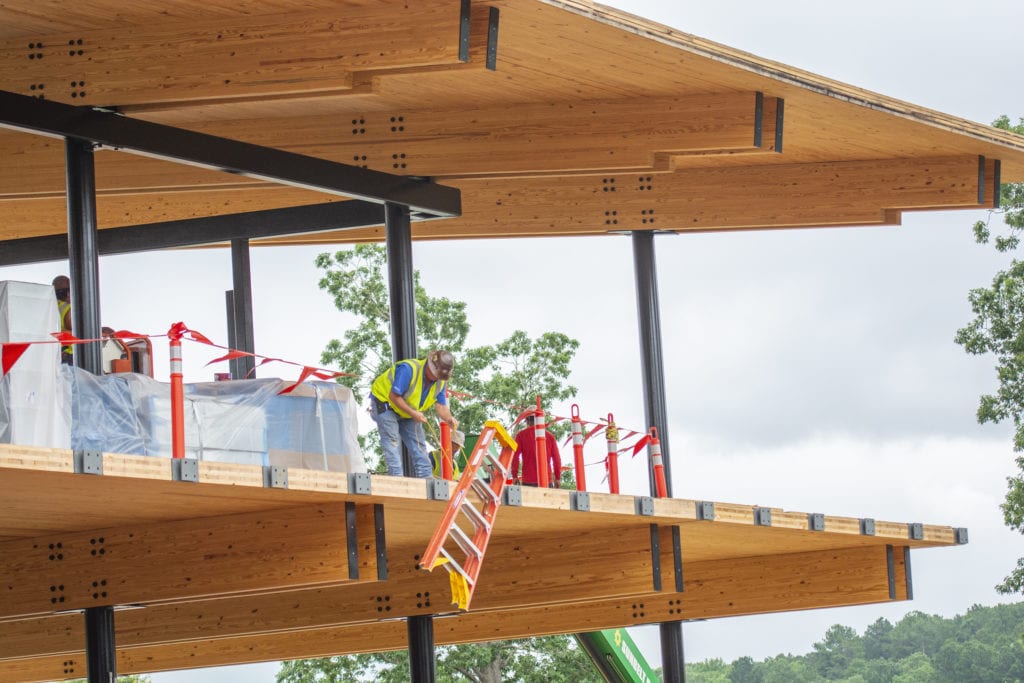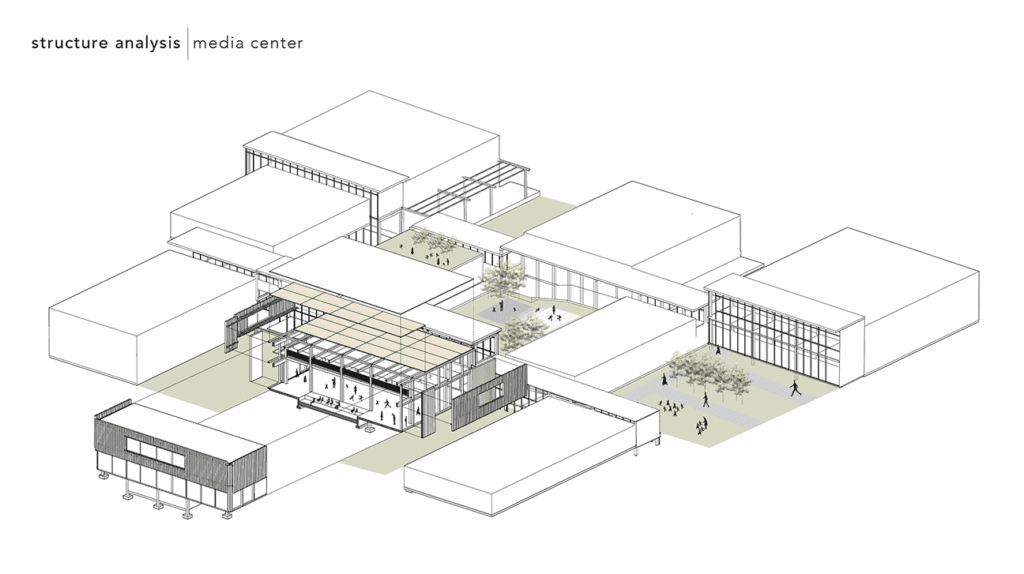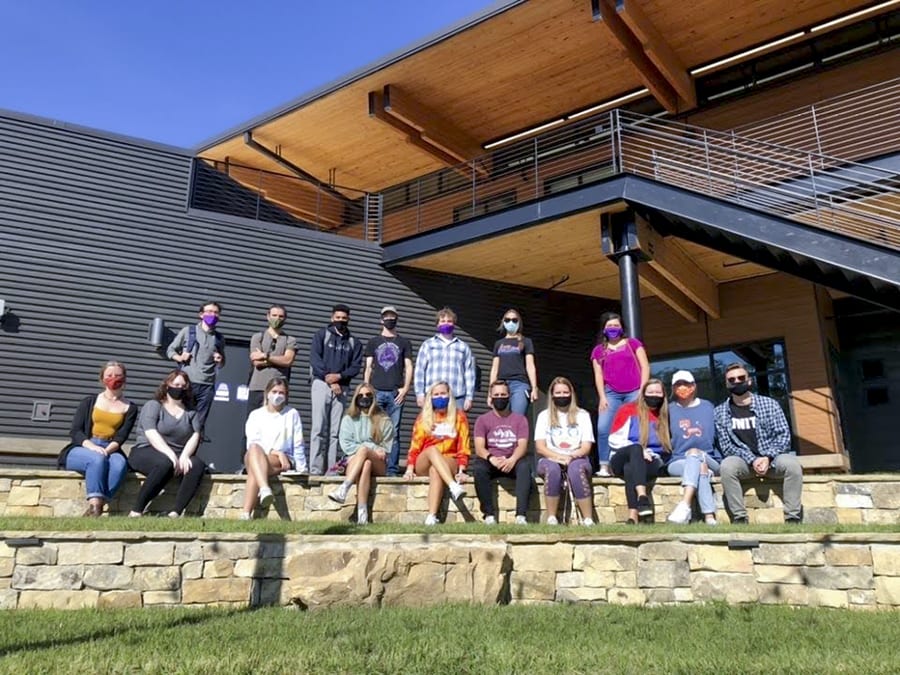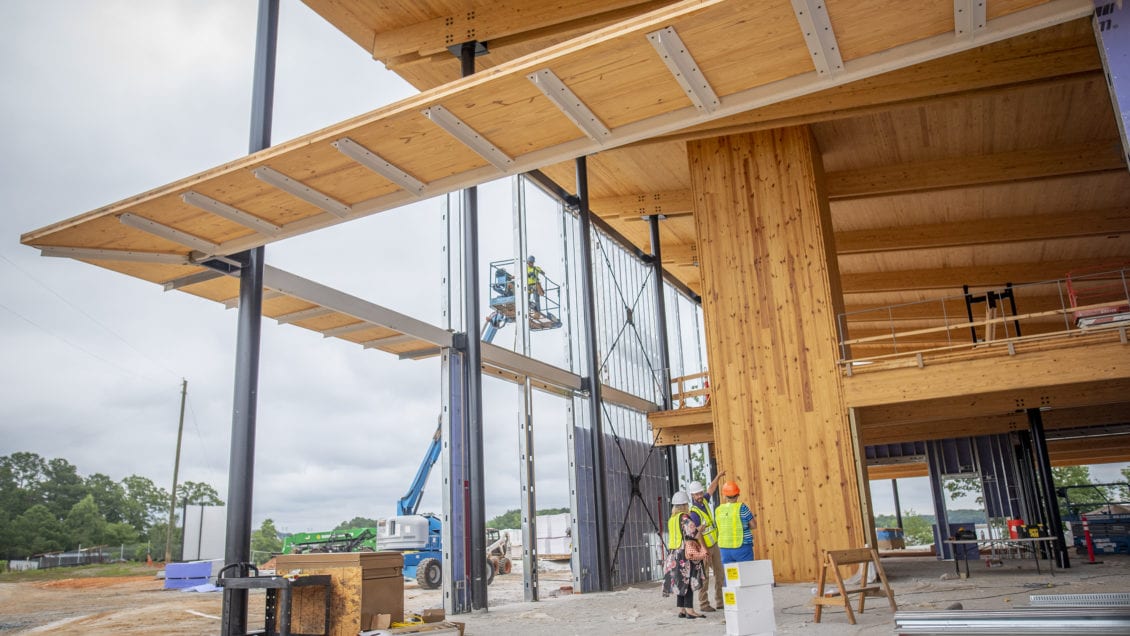Faculty and students in Clemson University’s School of Architecture are at the forefront of a structural system making building construction more sustainable and efficient. Mass timber buildings are roughly 25 percent faster to construct than concrete buildings and require 90 percent less construction traffic.
Last semester, students in associate professor of architecture Dustin Albright’s studio course teamed up with professionals from design firm LS3P to explore the use of massive timber (aka “mass timber”) systems for school buildings.
Mass timber systems comprise solid wood panels nailed or glued together from multiple layers of lumber. They provide exceptional strength and stability. It’s a strong, low-carbon alternative to concrete and steel. Clemson has been a leader in mass timber systems’ research and education, including cross-laminated timber, through its Wood Utilization + Design Institute (WU+D).
“Clemson is at the forefront of these building systems,” said Albright. “It’s becoming more and more popular, so knowing how to work with this system is going to be increasingly valuable for our students. We’re one of the first universities to teach it to our engineering and architecture students.”

On Clemson’s campus, WU+D researchers helped push for the Andy Quattlebaum Outdoor Education Center, the University’s first mass timber facility, to be designed with wood. It is one of the first in the world to be built with Southern pine cross-laminated timber.
Albright said it’s sort of like assembling a life-sized model kit.
“Everything is designed in a computer and then the computer programs the machines to cut out the pieces. You can make panels that are sometimes 12 feet wide by 60 feet long,” he explained. “Those panels go down a conveyer, and all the window and door openings are cut out, and they get routed and prepared for electrical systems, et cetera. All the preparation is done in the factory and then the pieces are shipped to site where they are put together very quickly.”
It was that efficiency LS3P was looking to learn about when they recruited Albright and 18 of his students to design a new elementary school with mass timber systems in mind for the Forest Acres community in Columbia, S.C. The firm was already well into the design of the actual school, but — using the details of the setting, the client and the school district — wanted to use Albright and his students’ expertise to learn what the benefits might have been if using mass timber systems on the project.
“We did a lot of presentations over Zoom,” laughed Albright. “It was invaluable for our students to have that kind of access to top-notch designers. What was great about it was how generous the LS3P staff were with their time. They didn’t just come in once or twice during the semester, popping in to learn about the project on the fly. They were there every step of the way.”
Katherine Peele, chief practice officer for LS3P, served as one of the mentors.
“Our LS3P design reviewers were incredibly impressed by the depth of the student research on mass timber, prior to the beginning of their student work,” said Peele. “They really took a deep dive and I think the resulting research findings will be a great preface to their project design work in the studio publication. We also were impressed with the quality and variety of the design projects and also the creative ways the students integrated mass timber into their work.”

LS3P was previously working with mass timber on other building types, like apartments, and was attracted to other benefits such as the small carbon footprint of these structures and the speed of construction. Since mass timber panels are prefabricated and then assembled on-site, buildings made from mass timber have much shorter project timelines and safer construction sites.
Clemson senior Ellie Kutz said the project was an eye-opener to her as an architecture major.
“One of the things that surprised me the most was learning how versatile mass timber systems can be,” she said. “These systems are important because they introduce a new method of designing with environmental consciousness. It has become more apparent in the last few years that we, as an industry, need to be more serious about considering how our projects interact with the site around them, not just architecturally but also environmentally. I definitely envision myself working with them in the future.”
Albright said the nature of the wood itself also contributes to the sustainability of the practice.
“Half the weight of timber that we use in buildings is stored carbon,” he said. “That’s a huge benefit, environmentally speaking. We learn as children about the dangers of deforestation, but, ironically, if you manage the forests well and replant the trees and use a whole set of best practices when it comes to sustainable forest management, then properly resourced timber is one of the most sustainable building materials we have, in large part because it breathes in carbon dioxide from the atmosphere.”

People have been building homes out of wood forever, said Albright, noting more than 90 percent of single-family homes in America are made of wood. Still, because of wood’s limitations, more significant buildings like offices, schools and department buildings had to be made out of concrete and steel. Mass timber systems are changing that.
“I always think about the old lodges out West in the national park system. They’re made of these huge timber beams. That beam is cut from one very large tree. To get buildings with that kind of capacity and those spans, you had to cut down lots and lots of trees and there was significant waste material,” said Albright. “Well, now we’re able to take smaller boards and glue them together and make beams, what’s called glulam, which has been around since the ’60s. What’s newer is panelized systems – cross-laminated timber is one example of a panelized system that can make whole walls, whole floors and roofs. All of this is couched under the heading of massive timber systems.”
Peele said she believes schools could potentially be a well-suited application for mass timber structural systems.
“The repetitive nature of classrooms, as well as the desire for a warm and humanistic environment for the students, makes mass timber a great candidate for structural systems for schools,” she said.
Student team member Elizabeth Vera, also a senior majoring in architecture, said working with mass timber systems on the project expanded the way she sees structural systems and materials.
“I was surprised at how expansive the development and use of these products were,” said Vera. “It was a different way of thinking about design than I had been able to do before. I was thinking about how to create a space with these different elements and how these elements work together both systematically and aesthetically. The structural system ended up taking its role to another level of detail and intention, which is something truly unique to this project. I definitely will be taking this experience with me as I continue to further my career.”
Albright said it isn’t just the process that’s more efficient, but the buildings themselves. Wood is a natural insulator, so the final structures get the additional insulating qualities from the material itself as opposed to steel or concrete, which transfer heat. The final aesthetic of the building can also be beneficial.
“There are studies looking at different stress levels and those kinds of things that show having natural exposed materials in your living, work or learning environment can have positive impacts on your physical and mental health,” he said. “So, there are long-lasting impacts in addition to efficiency and energy. All of that was what we wanted to address with the design of the elementary school.”
Albright, with the help of two student assistants, compiled his team’s research and various design proposals into a book that will be printed for the collaborators at LS3P and posted online.

